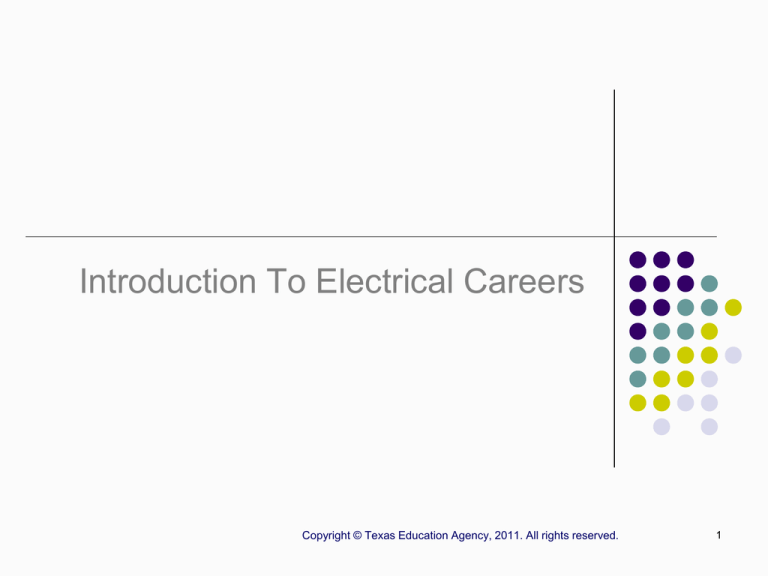Introduction To Electrical Careers 1
advertisement

Introduction To Electrical Careers Copyright © Texas Education Agency, 2011. All rights reserved. 1 Objectives Career Research Electrical Trades and Related Careers Explore Career Opportunities Identify Education, Training and Apprenticeships Copyright © Texas Education Agency, 2011. All rights reserved. 2 The Future Looks Bright Job satisfaction Excellent pay Challenging future Career movement Copyright © Texas Education Agency, 2011. All rights reserved. 3 Nature of the Work Electricity is essential for light, power, air conditioning, and refrigeration. Electricians install, connect, test, and maintain electrical systems for a variety of purposes, including climate control, security and communication. They also may install and maintain the electronic controls for machines in business and industry. Although most electricians specialize in construction or maintenance, a growing number do both. Copyright © Texas Education Agency, 2011. All rights reserved. 4 Work Activities Specifically Performed By Electricians Read blue prints to plan installation of electrical equipment. Install conduit, lighting, switches, panel and breakers, and pull wire for these circuit. Test and troubleshoot electrical systems to diagnose and repair problems. Follow federal,state, and local electrical and building codes. Copyright © Texas Education Agency, 2011. All rights reserved. 5 Aptitudes & Skills Perform math operations efficiently Spatial perception Use logical, step-by-step procedures. Working with high tech equipment Scientific related data Plan, layout and implement ideas, programs, and systems maintenance. Working with hands Supervise or train other electricians. Make decisions and solve problems. Perform activities that uses the whole body. Good interpersonal Communication skills. Updates job related knowledge Copyright © Texas Education Agency, 2011. All rights reserved. 6 Working Environment Physical Demands Stand for long periods of time. Climb ladders and scaffolds. Kneel, stoop, crouch, or crawl. Sometimes lift, push, pull, or carry heavy objects. Working under emergency and extreme circumstances. Working Conditions Often works outside in noisy surroundings. Work on new and sometimes old building . Work in cramp and confined sometimes poorly ventilated spaces. Sometimes works in dangerous and hazardous situation, with the possibility of falling or electrical shock. Copyright © Texas Education Agency, 2011. All rights reserved. 7 Related Careers Maintenance electricians spend much of their time in preventive maintenance. They periodically inspect equipment, and Locate and correct problems before breakdowns occur. Electrical inspectors examine the installation of electrical systems and Equipment to ensure they function properly and comply with electrical codes and standards. They visit work sites to inspect new and existing sound and security systems, wiring, lighting, motors, and generating equipment. They also inspect the installation of the electrical wiring for heating and air conditioning systems, appliances, and other components. Automotive electricians work exclusively with vehicle electrical and electronic systems. Electrical and electronics engineering technicians help design, develop, test, and manufacture electrical and electronic equipment such as radios, radar, sonar, television, industrial and medical measuring or control devices, navigational equipment, and computers. They may work in product evaluation and testing, using measuring and diagnostic devices to adjust, test, and repair equipment. Electrical and electronics engineers design, develop, test, and supervise the manufacture of electrical and electronic equipment. Electrical equipment includes power generating and transmission equipment used by electric utilities, and electric motors, machinery controls, and lighting and wiring in buildings, automobiles, and aircraft. Electronic equipment includes radar, computer hardware, and communications and video equipment. 8 Copyright © Texas Education Agency, 2011. All rights reserved. Preparation and Training Most electricians learn their Skills through apprenticeship training programs. Other preparations consist of: Apprenticeship programs consist of three to five years on-the-job training. In addition, each year you receive at least 144 hours of classroom training. Classroom subject include: electrical theory, codes, math, blueprint reading and safety practices. Taking courses at a professional technical school or two year colleges. Receiving informal on-the-job training from an experienced electrician. Trainees learn to install conduit, connect wires, and test circuits. Training usually last for several years. Military training is another options, in which you may earn credit for previous work experiences when you enter a civilian apprenticeship program. Copyright © Texas Education Agency, 2011. All rights reserved. 9 Helpful High School Courses A high school degree is usually required to work in this occupation. Many high schools today offering career technology and school-tocareer programs, in construction and building trades. Here are a list of courses that will help you prepare for this specific occupation: Construction Trades: Exploration of construction Careers, Electricity and Electronics, Residential and Industrial Wiring. Drafting: Blueprint Reading, and Drafting Electrical and Electronics Health and Safety Education: Safety and First Aid Industrial and Technology Education: Exploration of Careers, General Industrial Arts, and Industrial Safety and First Aid. Mathematics: Integrated Math, General Math, Applied Math, Algebra and Business Math. Business: Introduction to Business Copyright © Texas Education Agency, 2011. All rights reserved. 10 Occupational Outlook Many job openings will occur each year as current electricians retire or leave this occupation for other reasons. Much of the demand for electricians will result from growth in the economy and population. Electricians will be needed to help maintain wiring in existing buildings. They will also be needed to help add wiring to new buildings. In addition, new technologies should add to the need for electricians. Many houses and offices will need new wiring for computers. In addition, many factories are adding robots. Electricians will be needed to install them. Employment of electricians is sensitive to the state of the economy. Both construction electricians and motor vehicle electricians are affected by downturns in the economy. When construction and car buying decrease, these electricians may work fewer hours or be laid off. Copyright © Texas Education Agency, 2011. All rights reserved. 11 Nationally, the number of jobs for electricians expected to grow as fast as average through the year 2010. National Employment 2000 2010 698,400 818,900 Employment Change Number Percent 120,500 17.3 Advancement Opportunities Experienced electricians who work for large companies have everal options for advancement. Those who have good people skills may become supervisors. Those who have good organizational skills may become managers. Construction electricians may transfer to electrical jobs in the shipbuilding, automobile, or aircraft industries. Some electricians start their own businesses. Those who have a master electrician's license may Copyright © Texas Education Agency, 2011. All rights reserved. 12 become contractors.

